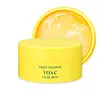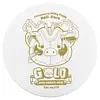What's inside
What's inside
 Key Ingredients
Key Ingredients

 Benefits
Benefits

 Concerns
Concerns

 Ingredients Side-by-side
Ingredients Side-by-side

Water
Skin ConditioningGlycerin
HumectantNiacinamide
SmoothingCarrageenan
1,2-Hexanediol
Skin ConditioningCeratonia Siliqua Gum
EmollientHydroxyacetophenone
AntioxidantGlucomannan
Skin ConditioningCalcium Chloride
AstringentChlorphenesin
AntimicrobialAllantoin
Skin ConditioningPropanediol
SolventChondrus Crispus
MaskingCyamopsis Tetragonoloba Gum
Emulsion StabilisingChondrus Crispus Powder
AbrasivePolyglyceryl-10 Laurate
Skin ConditioningPotassium Chloride
Pentylene Glycol
Skin ConditioningSucrose
HumectantPinus Sylvestris Leaf Extract
TonicAdenosine
Skin ConditioningEthylhexylglycerin
Skin ConditioningDipotassium Glycyrrhizate
HumectantDisodium EDTA
Melia Azadirachta Flower Extract
Skin ConditioningCocos Nucifera Fruit Extract
EmollientCitrus Aurantium Bergamia Fruit Oil
MaskingCitrus Tangerina Extract
TonicMelia Azadirachta Leaf Extract
Skin ConditioningAscorbyl Glucoside
AntioxidantCurcuma Longa Root Extract
MaskingOcimum Sanctum Leaf Extract
Skin ConditioningButylene Glycol
HumectantCorallina Officinalis Extract
Skin ConditioningCitrus Limon Peel Oil
MaskingCalcium Lactate
AstringentArbutin
AntioxidantLavandula Angustifolia Oil
MaskingCananga Odorata Flower Oil
MaskingCitrus Aurantium Dulcis Peel Oil
MaskingEucalyptus Globulus Leaf Extract
PerfumingTocopherol
AntioxidantPotassium Hydroxide
BufferingHyaluronic Acid
HumectantHydrolyzed Hyaluronic Acid
HumectantSodium Hyaluronate
HumectantLimonene
PerfumingLinalool
PerfumingWater, Glycerin, Niacinamide, Carrageenan, 1,2-Hexanediol, Ceratonia Siliqua Gum, Hydroxyacetophenone, Glucomannan, Calcium Chloride, Chlorphenesin, Allantoin, Propanediol, Chondrus Crispus, Cyamopsis Tetragonoloba Gum, Chondrus Crispus Powder, Polyglyceryl-10 Laurate, Potassium Chloride, Pentylene Glycol, Sucrose, Pinus Sylvestris Leaf Extract, Adenosine, Ethylhexylglycerin, Dipotassium Glycyrrhizate, Disodium EDTA, Melia Azadirachta Flower Extract, Cocos Nucifera Fruit Extract, Citrus Aurantium Bergamia Fruit Oil, Citrus Tangerina Extract, Melia Azadirachta Leaf Extract, Ascorbyl Glucoside, Curcuma Longa Root Extract, Ocimum Sanctum Leaf Extract, Butylene Glycol, Corallina Officinalis Extract, Citrus Limon Peel Oil, Calcium Lactate, Arbutin, Lavandula Angustifolia Oil, Cananga Odorata Flower Oil, Citrus Aurantium Dulcis Peel Oil, Eucalyptus Globulus Leaf Extract, Tocopherol, Potassium Hydroxide, Hyaluronic Acid, Hydrolyzed Hyaluronic Acid, Sodium Hyaluronate, Limonene, Linalool
Water
Skin ConditioningGlycerin
HumectantDipropylene Glycol
HumectantChondrus Crispus Powder
AbrasiveBenzyl Glycol
SolventCeratonia Siliqua Gum
EmollientButoxydiglycol
MaskingPEG-60 Hydrogenated Castor Oil
EmulsifyingXanthan Gum
EmulsifyingAllantoin
Skin ConditioningNiacinamide
SmoothingRaspberry Ketone
MaskingTocopheryl Acetate
AntioxidantSynthetic Fluorphlogopite
Dipotassium Glycyrrhizate
HumectantAdenosine
Skin ConditioningDisodium EDTA
Butylene Glycol
HumectantParfum
MaskingCalcium Lactate
AstringentCI 77891
Cosmetic ColorantPhenoxyethanol
PreservativeCI 77491
Cosmetic ColorantTin Oxide
AbrasivePolysorbate 20
EmulsifyingCI 77480
Cosmetic ColorantOligopeptide-1
Skin ConditioningWater, Glycerin, Dipropylene Glycol, Chondrus Crispus Powder, Benzyl Glycol, Ceratonia Siliqua Gum, Butoxydiglycol, PEG-60 Hydrogenated Castor Oil, Xanthan Gum, Allantoin, Niacinamide, Raspberry Ketone, Tocopheryl Acetate, Synthetic Fluorphlogopite, Dipotassium Glycyrrhizate, Adenosine, Disodium EDTA, Butylene Glycol, Parfum, Calcium Lactate, CI 77891, Phenoxyethanol, CI 77491, Tin Oxide, Polysorbate 20, CI 77480, Oligopeptide-1
Ingredients Explained
These ingredients are found in both products.
Ingredients higher up in an ingredient list are typically present in a larger amount.
Adenosine is in every living organism. It is one of four components in nucleic acids that helps store our DNA.
Adenosine has many benefits when used. These benefits include hydrating the skin, smoothing skin, and reducing wrinkles. Once applied, adenosine increases collagen production. It also helps with improving firmness and tissue repair.
Studies have found adenosine may also help with wound healing.
In skincare products, Adenosine is usually derived from yeast.
Learn more about AdenosineAllantoin is a soothing ingredient known for its protective and moisturizingg properties. Because of this, it is often added to products with strong active ingredients.
Studies show higher concentrations of this ingredient can promote wound healing.
Though it can be derived from the comfrey plant, allantoin is produced synthetically for cosmetic products to ensure purity.
Learn more about AllantoinButylene Glycol (or BG) is used within cosmetic products for a few different reasons:
Overall, Butylene Glycol is a safe and well-rounded ingredient that works well with other ingredients.
Though this ingredient works well with most skin types, some people with sensitive skin may experience a reaction such as allergic rashes, closed comedones, or itchiness.
Learn more about Butylene GlycolCalcium Lactate is created by combining lactic acid with calcium carbonate or calcium hydroxide.
Ceratonia Siliqua Gum is extracted from the seeds of the carob tree. You might know this ingredient as Carob Gum or Locust Bean Gum. It is used to stabilize other ingredients and improve the texture of products.
Carob gum is made up of long-chain polysaccharides. This makes it a natural thickener.
Yes! This ingredient comes from the seeds of a tree. The name 'Locust Bean Gum' can be misleading.
Learn more about Ceratonia Siliqua GumChondrus Crispus Powder is an exfoliant.
Dipotassium Glycyrrhizate comes from licorice root.
Extracts of licorice have demonstrated to have antibacterial, anti‐inflammatory, antiviral, antioxidant properties.
One component, glabridin, has extra potent antioxidant and soothing properties. It has also been found to block pigmentation from UVB rays in guinea pigs.
Licorice Root also contains a flavonoid. Flavonoids are a natural substance from in plants. Flavonoids also have antioxidant properties.
Another component, glycyrrhizin, has been found to have anti-inflammatory and antimicrobial benefits. This may make licorice root extract effective at treating acne. However, more research is needed to support this.
Liquiritin is one of the flavone compounds found in licorice. It has been found to help lighten skin by preventing tyrosinase from reacting with tyrosine. When the two react, protein is converted to melanin. Melanin is the substance in your body that gives your features pigmentation.
Licorice root is native to Southern Europe and Asia. It has been used in traditional Chinese medicine to help with respiratory issues.
Learn more about Dipotassium GlycyrrhizateDisodium EDTA plays a role in making products more stable by aiding other preservatives.
It is a chelating agent, meaning it neutralizes metal ions that may be found in a product.
Disodium EDTA is a salt of edetic acid and is found to be safe in cosmetic ingredients.
Learn more about Disodium EDTAGlycerin is already naturally found in your skin. It helps moisturize and protect your skin.
A study from 2016 found glycerin to be more effective as a humectant than AHAs and hyaluronic acid.
As a humectant, it helps the skin stay hydrated by pulling moisture to your skin. The low molecular weight of glycerin allows it to pull moisture into the deeper layers of your skin.
Hydrated skin improves your skin barrier; Your skin barrier helps protect against irritants and bacteria.
Glycerin has also been found to have antimicrobial and antiviral properties. Due to these properties, glycerin is often used in wound and burn treatments.
In cosmetics, glycerin is usually derived from plants such as soybean or palm. However, it can also be sourced from animals, such as tallow or animal fat.
This ingredient is organic, colorless, odorless, and non-toxic.
Glycerin is the name for this ingredient in American English. British English uses Glycerol/Glycerine.
Learn more about GlycerinNiacinamide is a multitasking form of vitamin B3 that strengthens the skin barrier, reduces pores and dark spots, regulates oil, and improves signs of aging.
And the best part? It's gentle and well-tolerated by most skin types, including sensitive and reactive skin.
You might have heard of "niacin flush", or the reddening of skin that causes itchiness. Niacinamide has not been found to cause this.
In very rare cases, some individuals may not be able to tolerate niacinamide at all or experience an allergic reaction to it.
If you are experiencing flaking, irritation, and dryness with this ingredient, be sure to double check all your products as this ingredient can be found in all categories of skincare.
When incorporating niacinamide into your routine, look out for concentration amounts. Typically, 5% niacinamide provides benefits such as fading dark spots. However, if you have sensitive skin, it is better to begin with a smaller concentration.
When you apply niacinamide to your skin, your body converts it into nicotinamide adenine dinucleotide (NAD). NAD is an essential coenzyme that is already found in your cells as "fuel" and powers countless biological processes.
In your skin, NAD helps repair cell damage, produce new healthy cells, support collagen production, strengthen the skin barrier, and fight environmental stressors (like UV and pollution).
Our natural NAD levels start to decline with age, leading to slower skin repair, visible aging, and a weaker skin barrier. By providing your skin niacinamide, you're recharging your skin's NAD levels. This leads to stronger, healthier, and younger looking skin.
Another name for vitamin B3 is nicotinamide. This vitamin is water-soluble and our bodies don't store it. We obtain Vitamin B3 from either food or skincare. Meat, fish, wheat, yeast, and leafy greens contain vitamin B3.
The type of niacinamide used in skincare is synthetically created.
Learn more about NiacinamideWater. It's the most common cosmetic ingredient of all. You'll usually see it at the top of ingredient lists, meaning that it makes up the largest part of the product.
So why is it so popular? Water most often acts as a solvent - this means that it helps dissolve other ingredients into the formulation.
You'll also recognize water as that liquid we all need to stay alive. If you see this, drink a glass of water. Stay hydrated!
Learn more about Water